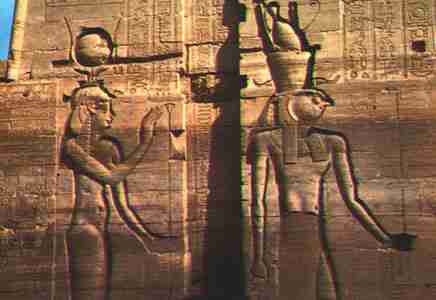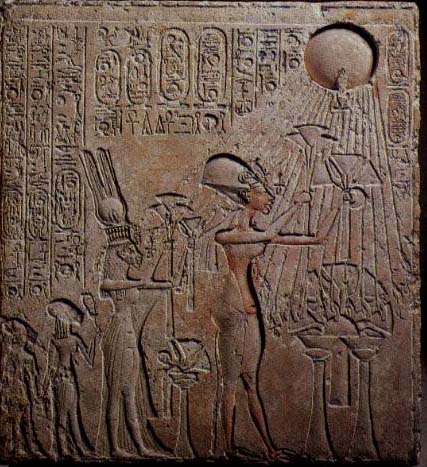SUN DISCSSolar symbols can be found in the art of most civilizations. The Sun is the Symbol of Creation - Source - The Eye. The sun - represents solar activity - the Creational Flame - the Creational Source - the place where all things begin and return - during a 'Cycle of Time'. Each soul is a spark of light created by this Source.
EGYPT
Many of the Egyptian Gods wore solar discs.


Nut - Egyptian Solar Disc
On the Southern section of this image - Nut has ten solar disks running along her body, as well as one at her mouth and another one at the birth canal between her legs painted with the image of Khepri (the god of coming into being). No disks are depicted on the northern facing Nut because the sun is always seen to traverse the southern part of the sky in Egypt.

Nut and Geb

Ra

Isis

Solar disc relief - Akhenaten worshipping the Sun God - Aton
The Great Aten The God and Disk of the Sun 
Symbol of Aton
In connection with the Sun-gods of Egypt and with their various forms which were worshipped in that country must be considered the meager facts which we possess concerning Aten, who appears to have represented both the god or spirit of the sun, and the solar disk itself.
The origin of this god is wholly obscure, and nearly all that is known about him under the Middle Empire is that he was a small provincial form of the Sun-god which was worshipped in one little town in the neighborhood of Heliopolis, and it is possible that a temple was built in his honor, in Heliopolis itself.
It is idle to attempt to describe the attributes which were orginally ascribed to him under the Middle or Early Empire, because the texts which were written before the XXIIIrd Dynasty give us no information on the subject.
Under the XVIIIth Dynasty, and especially during the reigns of Amen-Ra-Heru-khuti, Horus, etc., but it does not follow that they orginally belonged to him. In the Theban Recesion of the Book of the Dead, which is based upon Heliopolitan, we find Aten mentioned by the deceased thus : -
"Thou, O Ra, shinest from the horizon of heaven, and Aten is adored when he resteth {or setteth} upon this mountain to give life to the two lands. Hunefer says Ra, Hail, Aten, thou the lord of beams of light, {when} thou shinest all faces {i.e., everybody} lives. Nekht says Ra, O thou beautiful being, thou doest renew thyself and make thyself young again under the form of Aten; Ani says Ra, Thou turnest thy face towards the Underworld, and thou makest the earth to shine like fine copper. The dead rise up to thee, they breath the air and they look upon thy face when Aten shineth in the horizon; I have come before thee that I may be with thee to behold thy Aten daily: O thou who art in thine Egg, who shinest from thy Aten," etc.
These passages show that Aten, at the time when the hymns from which they are taken were composed, was regarded as the material body of the sun wherein dwelt the god Ra, and that he represented merely the solar disk and was visible emblem of the great Sun-god.
In later times, coming to protection afforded to him by Amen-hetep III, the great warrior and hunter of the XVIII Dynasty, other views were promulgated concerning Aten, and he became the cause of one the greatest religious and social revolutions which ever convulsed Egypt.
After the expulsion of Hyksos, Amen, the local god of Thebes, as the god of the victorious princess of that city, became the head of the company of the gods of Egypt, and the early kings of the XVIIIth Dynasty endowed his shrine with possessions, and gave gifts to his priesthood with a lavish hand.
In spite of this however, some of these kings maintained an affection for the forms of the Sun-god which were worshipped at Heliopolis, and Thothmes IV, it will be remembered, dug out the Sphinx from the sand which had buried him and his temple, and restored the worship of Ra-Harmachis.
He was not the only monarch who viewed with disamy the great and growing power of the priests of Amen-Ra, the "king of the gods" at Thebes.
Amen-hetep III, the son of Thothmes IV, held the same views as his father in this respect, and he was, apparently, urged to give effect to them by his wife Thi, the daughter of Iuaa and Thuau, who was a foreigner and who was in no way connected with the royal house of Egypt.
Having married this lady, he gave her as dowry the frontier city of Tcharu, and her natural ability, coupled with the favor of her husband, made her chief of all the royal wives, and a great power in the affairs of the government of the country.
It has been thought by some that she was a native of the country near Heliopolis, and it is possible that she herself was a votary of Aten, but be that as it may, she appears to have supported the king in his determation to encourage the worship of the god.
At an early period in his reign he built one at Thebes, quite close to the great sanctuary of Amen-Ra, the priests of whom were, of course, powerless to resist the will of such an active and able king.
Soon after his marriage with Thi, Amen-hetep III, dug, in his wife's city of Tcharu, a lake, which was about 6000 feet long by 1000 feet broad.
On the day of the festival when the water was allowed to flow into it, he sailed over it in a boat called "Aten-neferu, i.e., the "Beauties of Aten ;" the name of the boat is a clear proof of his devotion to the god Aten. Amen-hetep IV, the son of Amen-hetep III. by the foreign lady Thi, not only held the religious views of his father, but held them very strongly.
His life shows that he must have been from his youth of an adherent of the worship of Aten; it is supposed, and with much probability, that the intensity of his love for Aten and his hatred for Amen-Ra were due to his mother's influence.
Amen-hetep IV succeeded his father without difficulty, even though his mother was not a member of the royal family of Egypt, and for the first few years of his reign he followed the example of the earlier kings of his dynasty, and lived at Thebes, where he no doubt ruled according to his mothers wishes.
He offered up sacrifices to Amen-Ra at the appointed seasons, an was, outwardly at least, a loyal servent of this god, whose name formed a part of his name as "son of the Sun." We may note in passing, that he adopted on his accession to the throne the title "High-priest of Ra-Heru-khuti, the exalted one of the horizon, in his "name of Shu who is in Aten," which is clear proof that he was not only a worshiper of Ra-Harmachis, another of the forms of the Sun-god Heliopolis, but also that he endorsed the views and held the opions of the old College of Priests at Heliopolis, which assigned the disk {Aten} to him for a dwelling-place.
Amen-hetep's titles as lord of the shrines of the cities of Nekhebet and Uatchet, and as the Horus of gold also prove his devotion to a Sun-god of Heliopolis. During the early years of his reign at Thebes he built a massive Benhen, in honor of Ra-Harmachis at Thebes, and it is probable that he took the opportunity of restoring or enlarging the temple of Aten which had been built by his father.
At the same time we find that he worshipped both Amen and Aten, the former in his official position as king, and the latter in his private capacity. It was, however, impossible for the priests of Amen -Ra to tolerate the presence of the new god Aten and his worship in Thebes, and the relations between the king and that powerful body soon became strained.
On the one hand the king asserted the superiority of Aten over every god, and on the other the priests declared that Amen-Ra was the king of the gods.
As, however, Amen-Ra was the center of the social life of Thebes, and his priests and their relatives included in their number the best and greatest families of the capitol city, it came to pass that the king found himself at the worship of Aten wholly supported by the great mass of its population, whose sympathies were with the old religion of Thebes, and by those who gained their living in connection with the worship of Amen-Ra.
The king soon realized that residence in Thebes was becoming impossible , and the fifth year of his reign he began to build a new capitol on the east bank of the Nile, near a place which is marked to-day by the Arab villages of Haggi Kandil and Tell el-Amarna ; he planned that it should include a great temple to Aten, a palace for the king, and houses for those who were attached to the worship of Aten and were prepared to follow their king there.
While the new capitol was in the process of building the dispute between the king and the priests of Amen-Ra became more severe, and matters were much aggravated by Amenhetep IV.
At length the king left Thebes an took up his abode in his new capitol, which he called "Khut-Aten," i.e., "Hotizon of Aten," and as a sign of the entire severance of his connection with traditions of his house in respect of Amen-Ra he discarded his name "Amen-hetep" and called himself Khut-Aten i.e., "Glory of Aten," or, "Spirit of Aten."
At the time he changed his Horus name of "Exalted One of the double plumes" to "Mighty Bull, beloved of Aten" {or, lover of Aten}, and he adopted as lord of the shrines of Nekhebet and Uatchet the title of "Mighty one of sovereignity in Khut-Aten," and as the Horus of gold he styled himself, "Exalter of the name Aten."

